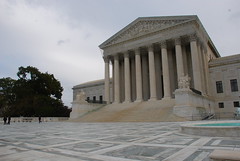 Image by gmaresign via Flickr
Image by gmaresign via FlickrEarly today, 05 December 2009, President Gloria Macapagal-Arroyo issued Proclamation No. 1959 placing the province of Maguindanao under martial law.
Article VII, Section 18 of the 1987 Constitution provides that the President as Commander-in-Chief of all armed forces of the Philippines and whenever it becomes necessary, may call out such armed forces to prevent or suppress lawless violence, invasion or rebellion.
In case of invasion or rebellion, when the public safety requires it, he may, for a period not exceeding sixty days, suspend the privilege of the writ of habeas corpus or place the Philippines or any part thereof under martial law. Obviously, there is no invasion in Maguindanao to warrant the declaration of martial law which leaves only rebellion as the basis for its declaration.
Article 134 of the Revised Penal Code, as amended by Republic Act No. 6968, states that rebellion or insurrection is committed by rising publicly and taking arms against the Government for the purpose of removing from the allegiance to said Government or its laws, the territory of the Philippine Islands or any part thereof, of any body of land, naval or other armed forces, depriving the Chief Executive or the Legislature, wholly or partially, of any of their powers or prerogatives.
Prior to the declaration of martial law, a sizable arms cache was recovered near the residence of the Ampatuan clan enough to arm more than a thousand men. Yesterday, the Ampatuans were able to secure a favorable ruling from the Court of Appeals in Cagayan De Oro City granting their application for a writ of amparo. Government forces also took into custody the patriarch of the Ampatuan clan, Andal Sr., and the ARMM Governor Zaldy Ampatuan. Subsequently, the government received intelligence reports that allegedly armed men started to group in various part of Maguindanao.
The last alleged event of armed men grouping apparently ignited the declaration of martial. Whether that alleged event constitutes "rising publicly and taking arms against the Government for the purpose of removing from the allegiance to said Government" is a question of fact that goes into the basis for the declaration of martial law. Simply put, was there a state of rebellion as defined under the law to justify martial rule?
The declaration of martial law appears to be, first and foremost, a clever political decision, even with very minimal legal basis. When the President visited General Santos City last Thursday to condole with the victims of the massacre, she was faced with grieving families who communicated to the President their sentiments and disappointments on how the government has treated the suspects with kid's gloves, considering the scale and barbarism of the incident.
By declaring martial law, the President, who is least concerned now with popularity, has deflected serious criticisms on her anemic responses to the massacre, as most critical of her handling of the incident are now focused on whether there is legal basis to her declaration or not. In effect, the declaration is a classic political maneuver to silence mounting criticisms of the massacre, and shift public attention to the legal basis of the declaration of martial law, as the latter appears to have profound impact on a national scale more than the massacre.
The shift in attention and media focus will be clearer in the coming days as the President will submit a report in Congress within forty-eight (48) hours from the declaration of martial law. The debates will be in Congress, voting jointly, by a vote of at least a majority of all its members, to revoke such declaration or even extend it for such period if the invasion or rebellion shall persist and public safety requires it.
We just hope that the declaration of martial law will not muffle the cries for justice of those massacred, or that justice be sidelined in the arena of political convenience.









![Reblog this post [with Zemanta]](http://img.zemanta.com/reblog_e.png?x-id=f9e84724-fae7-4ccd-889b-c409eb49177e)





